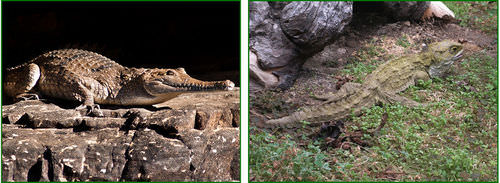10.11 爬虫
章节大纲
-
What does this chameleon have in common with a snake?
::这个变色龙和蛇有什么共同点?Though they are both reptiles and seem very different, chameleons and snakes actually share several traits. For example, they both have skin covered in scales and are cold-blooded animals . But notice the distinct on the chameleon. Snakes don't have these. And some chameleons have the ability to change color.
::虽然它们既是爬行动物,而且看起来也非常不同,但变色龙和蛇实际上有几种不同的特征。例如,它们都有皮肤覆盖的尺寸,都是冷血动物。但请注意变色龙的区别。蛇没有这些。有些变色龙有能力改变颜色。Characteristics of Reptiles
::爬行动物的特点What reptiles can you name? Snakes, alligators, and crocodiles are all reptiles. Modern reptiles live on every continent except Antarctica. They range in size from the newly-discovered Jaragua Sphaero (a dwarf gecko), at 0.6 inches, to the saltwater crocodile, at up to 23 feet.
::爬行动物叫什么来着?蛇、鳄鱼和鳄鱼都是爬行动物。现代爬行动物生活在南极洲以外的每个大陆。它们大小不一,从新发现的Jaragua Sphaero(侏儒壁)0.6英寸到盐水鳄,高达23英尺。There are four living orders of reptiles:
::爬行动物有四种活的顺序:-
Squamata
, which includes lizards, snakes, and amphisbaenids (or “worm-lizards”).
::水俣,包括蜥蜴、蛇和两栖动物(或“寄生虫皮”)。 -
, which includes crocodiles, gharials (
Figure
), caimans, and alligators.
::包括鳄鱼、长吻鳄、鳄鱼、鳄鱼和鳄鱼。 -
Testudines
, which includes
and tortoises.
::包括海龟和海龟的睾丸 -
Sphenodontia
, which includes tuatara (
Figure
).
::包括Tauatara(图)。
A gharial crocodile ( left ). A tuatara ( right ).
::长须鳄鱼(左),拉塔拉鳄鱼(右)。Traits of Reptiles
::爬迹轨迹Reptiles are tetrapods (four-legged) and ectothermic , meaning their internal temperature depends on the temperature of their environment. This is why you may see reptiles sunbathing as they use the energy from the sun to warm their bodies. Usually the sense organs of reptiles, like ears, are well developed, though snakes do not have external ears. All reptiles have advanced eyesight. Reptiles also have a sense of smell . Crocodilians, turtles, and tortoises smell like most other land vertebrates . But, some lizards, and all snakes, smell with their tongues, which is flicked out of the mouth to pick up scent molecules from the air.
::爬虫类是四肢和切热的, 意思是它们的内温取决于其环境的温度。 这就是为什么你可以看到爬虫类在用太阳的能量来温暖身体时晒太阳。 通常爬虫类的感官器官像耳朵一样发育良好, 虽然蛇没有外耳。 所有爬虫类都有先进的视力。 爬虫类也有嗅觉。 鳄鱼、 龟和乌龟的嗅觉像其他大多数陆脊椎动物一样。 但是, 一些蜥蜴和所有蛇, 都用舌头闻, 舌头从嘴里抽出, 从嘴里取出气味分子。Reptiles also have several adaptations for living on land. They have a skin covered in scales to protect them from drying out. All reptiles have lungs to breathe air. Reptiles are also amniotes , which means their embryos are surrounded by a thin membrane. This membrane protects the embryo from the harsh conditions of living on land. Reptile eggs are also surrounded by a protective shell, which may be either flexible or inflexible.
::爬虫类也有几种适应性适应性适应性适应性适应性适应性适应性适应性适应性适应性适应性适应性适应性适应性适应性适应性适应性适应性适应性适应性适应性适应性适应性适应性适应性适应性适应性适应性适应性适应性适应性适应性适应性适应性适应性适应性适应性适应性适应性适应性适应性适应性适应性适应性适应性适应性适应性适应性适应性适应性适应性适应性适应性适应性适应的适应性适应性适应性适应性适应性适应性适应性适应性适应性适应性适应性适应性适应性适应性适应性适应性适应性适应性适应性适应性适应性适应性适应性适应性适应性适应性适应性适应性适应性适应性适应性适应性适应性适应性适应性适应性适应性适应性适应性适应性适应性适应性适应性适应性适应性适应性适应性适应性适应性适应性适应性适应性适应性适应性适应性适应性适应性适应性适应性适应性适应性适应性适应性适应性调整性适应性适应性适应性适应性适应性适应性适应性适应性适应性适应性适应性适应性适应性适应性适应性适应性适应性适应性适应性适应性适应性适应性适应性适应性适应性适应性适应性适应性适应性适应性适应性适应性适应性适应性适应性适应性适应性适应性适应性适应性适应性适应性适应性适应性适应性适应性适应性适应性适应性适应性适应性适应性适应性适应性适应性适应性适应性适应性适应性适应性适应性适应性适应。How Do Reptiles Reproduce?
::爬行动物是如何繁殖的?Most reptiles reproduce sexually, meaning there are two parents involved. In some families of lizards and one snake family , however, asexual reproduction is possible. This is when only one parent is involved in creating new life. For example, the gecko females can make tiny clones of themselves without the aid of a male.
::大部分爬行动物是性繁殖的,这意味着父母双亲都参与其中,然而,在一些蜥蜴和蛇族家庭中,性生殖是可能的,只有一方父母参与创造新生活,例如,壁虎雌性雌性可以在没有男性帮助的情况下制造小型克隆人。All reptiles have a cloaca , a single exit and entrance for , eggs, and waste, located at the base of the tail. Most reptiles lay amniotic eggs covered with leathery or hard shell. These eggs can be placed anywhere as they don't have to be in a moist environment, like the eggs of . However, not all species lay eggs, as certain species of squamates can give birth to live young.
::所有爬行动物都有一个木薯,一个出口和入口,蛋和废物都位于尾巴底部。大多数爬行动物产的都是被皮革或硬壳覆盖的羊蛋。这些蛋可以放置在任何地方,因为它们不必在潮湿的环境中,如...的蛋。然而,并非所有物种都产卵,因为某些物种的同源动物可以生出年轻的生命。Unlike the amphibians, there are no larval stages of development. The young reptiles look like miniature versions of the adult. The young reptiles are generally left to fend for themselves. However, some reptiles provide care for their young. For example, crocodiles and alligators may defend their young from predators .
::与两栖动物不同的是,没有发育的幼年阶段,年轻的爬行动物看起来像成人的迷你版,年轻的爬行动物一般只能靠自己谋生,但是,有些爬行动物照顾自己的年轻人。例如,鳄鱼和鳄鱼可以保护自己的年轻人免受掠食动物的侵害。Summary
::摘要-
Reptiles are also amniotes, which means their embryos are surrounded by a thin membrane.
::爬虫也是羊膜,这意味着它们的胚胎被薄膜环绕。 -
Reptiles typically reproduce sexually and lay eggs.
::爬虫类通常繁殖性欲和产卵。
Explore More
::探索更多-
Greatest Misconception 1: Birds Evolved from Dinosaurs
at
(2:06)
::最大误解1:2:06时从恐龙传来的鸟类。
-
How does the stance of reptiles compare to the stance of birds?
::爬行动物的姿势如何与鸟类的姿势相比? -
Compare and contrast modern reptiles to modern birds. Include as many characteristics for both groups as you can.
::比较和对比现代爬行动物与现代鸟类。 尽可能多地包含两个群体的特点 。 -
Do ancient "reptiles" have all the same characteristics as present day reptiles? Explain your answer fully.
::古代的"异种"是否具有和今天的爬虫一样的特征?
Review
::回顾-
Name four examples of reptiles.
::举四个爬行动物的例子。 -
What is ectothermic?
::什么是切热? -
What are the reptilian adaptations for life on land?
::爬行动物对陆上生活有什么适应性? -
Compared to the amphibian egg, what is special about the reptile egg?
::与两栖卵相比 爬行动物蛋有什么特别之处?
-
Squamata
, which includes lizards, snakes, and amphisbaenids (or “worm-lizards”).

